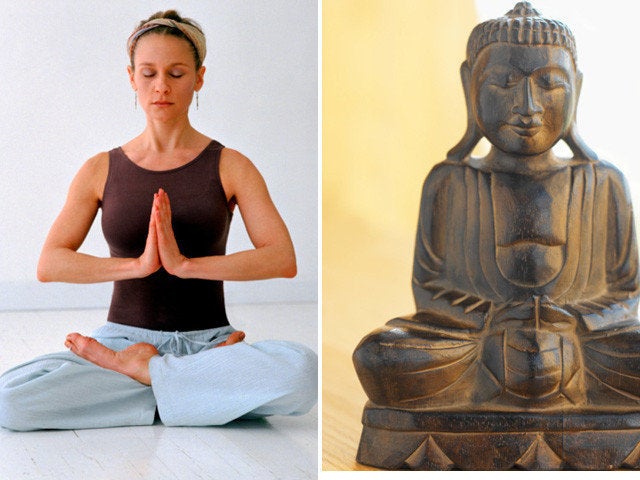
Ordinarily when we can't handle powerful feelings such as pain or fear we avoid them because they overwhelm us or make us feel bad. This creates a self-reinforcing cycle of anxiety and avoidance, guilt and shame. What I call Behavioral Buddhism is my own way of using certain core principles of classical Buddhist meditation to constructively challenge this destructive pattern because it teaches us how to consciously develop the capacity to sit with, just be with, what we once avoided.
Human experience, according to one version of the classical Buddhist model of the mind, occurs in one of six areas -- the five senses plus thinking. If we add "feeling" then we have seven potential domains to pay attention to.
Try this experiment. Take a piece of paper and make seven columns down the page. Think about areas of experience that are easiest and hardest for you to handle. Now list them at the top of each column -- going from easiest to most difficult. For example, if sound is easier to handle than sight, write it on the left. If feelings are harder to handle than sight, write it on the right. Do this with the five senses as well as thinking and feeling.
Now do the same thing within each column -- write the easiest type of experience within each category on the top row and the hardest on the bottom. For example, if the first column is sound, your favorite music might be easiest sound to handle, which would be listed in the top row of the column followed by something slightly more difficult, say police sirens outside your home, or cellphones nearby when you are trying to concentrate. Jackhammers outside your home when you are trying to work might be underneath. At the bottom of the column, write the most difficult sound, say screaming. In the "feeling" column joy might be at the top of the column and shame and humiliation might be at the bottom.
Which of the above seven zones of experience (the five senses plus thinking and feeling) are you most comfortable with? Write it in the top left-hand box. Pick the next area of the seven that you are most comfortable with and write it in the next topmost box. Continue until you have filled in all seven boxes across the top of the chart. The last box on the right will contain the realm you are least comfortable in.
Now do the same thing within each column. Starting under each of the seven zones of experience write in the top box the easiest experience to tackle within that area. Underneath the top box, list a slightly more difficult experience. Underneath that, list an even more challenging one. Beneath that, list a harder experience. On the bottom row, list the hardest experience within that zone of experience. What we now have is a chart of the seven different zones of experience and a descending list of challenging aspects of each. Take the first item in the first column, for example, sight. The easiest may be a beautiful landscape, a more challenging one could be something that you don't find attractive, and the most difficult one might be a sight that disturbs you, say pictures of bloodshed or children living in poverty.
Do a few minutes of yogic breathing followed by meditating on your favorite music. Sit in a comfortable chair and try to really hear the music when you are listening to it. If your mind wanders, return without any judgment to concentrating on the music.
What we usually don't realize is that we can grow our capacity for equanimity -- for sitting with and through challenging experiences. If we can open to the easiest aspect of one of the seven areas of experience -- for example, favorite music -- then we can be receptive to something slightly more difficult. If we can do that, then we can open to something harder because it is the same capacity -- one that can be trained.
The way to practice behavioral Buddhism is to work down the first column on the left -- your easiest domain of experience -- until you feel you can handle more difficult experiences. Move on to the next column when you feel comfortable. And so on.
What you will discover is that not only will your faith in your resilience grow, but you will become more open to the full range of human experience.. And as you do, your world will enlarge and you will literally become more responsible, more capable of responding to a greater range of experience without either getting lost in it or pushing it away.